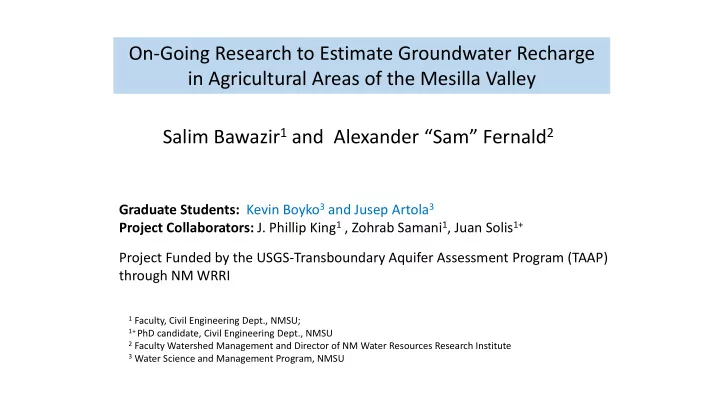

On-Going Research to Estimate Groundwater Recharge in Agricultural Areas of the Mesilla Valley Salim Bawazir 1 and Alexander “Sam” Fernald 2 Graduate Students: Kevin Boyko 3 and Jusep Artola 3 Project Collaborators: J. Phillip King 1 , Zohrab Samani 1 , Juan Solis 1+ Project Funded by the USGS-Transboundary Aquifer Assessment Program (TAAP) through NM WRRI 1 Faculty, Civil Engineering Dept., NMSU; 1+ PhD candidate, Civil Engineering Dept., NMSU 2 Faculty Watershed Management and Director of NM Water Resources Research Institute 3 Water Science and Management Program, NMSU
Background • Mesilla Valley Aquifer (Mesilla Bolson) is a trans-boundary aquifer shared between New Mexico, Texas and Mexico • Significant portion of the drinking water supply for the City of El Paso and Juarez • Main source of drinking water for residents of Mesilla Valley • Main source of irrigation water during dry years • The aquifer is vital for the sustainability of the agricultural industry, economic development and the quality of life in Southern New Mexico, El Paso, and Juarez • The long-term management and sustainability of the Aquifer depend on understanding the dynamic of the aquifer
Upper (Top) Boundary Layer (i.e. ET) of Project Objectives: Groundwater model has often been assumed - Measure Evapotranspiration (ET) of one of the major crops (i.e. Alfalfa ) in the Mesilla Valley - Measure ET of fallow farm field - ET of fallow ground has not been well quantified in the hydrologic budget; Often considered “miniscule” and therefore considered “zero” - Use Ground level ET measurements to verify remote sensing ET Models [Mesilla Valley ET] - Estimate groundwater recharge based on irrigation practices
Measurement Locations Salopek : 84 acres (34 ha) Willies : 87 acres (35.2 ha)
Climate Station Eddy Covariance System Soil Moisture Profile Depth to Groundwater Leyendecker Climate Station (NMSU: Leyendecker Plant Science Station) Willies Farm – Alfalfa (Eddy Covariance System and Climate Station)
Salopek Fallow Farmland – Alfalfa (Eddy Covariance System and Climate Station)
Preliminary Results: ET of alfalfa = 4.6 ft (1403 mm) Precipitation = 11 in or 0.92 ft (277 mm) Irrigation Applied = 5.67 ft (1729 mm) N= 271 days of data collection Recharge to Groundwater: 1.0 - 1.5 ft
Remote Sensing Model Estimates – Sample of REEM Estimates 2/25/2017 Willie’s Farm; Measured ET Values and Remote Sensing REEM ET Estimates 2/25/2017 Measured = 2.03 mm REEM Satellite Model = 2.00 mm (avg.) 3/13/2017 Measured = 4.9 mm REEM Satellite Model = 4.00 mm (avg.) Improving Remote Sensing ET Models (REEM and SSEBop) is in Progress for the Mesilla Valley
Thank you
Recommend
More recommend